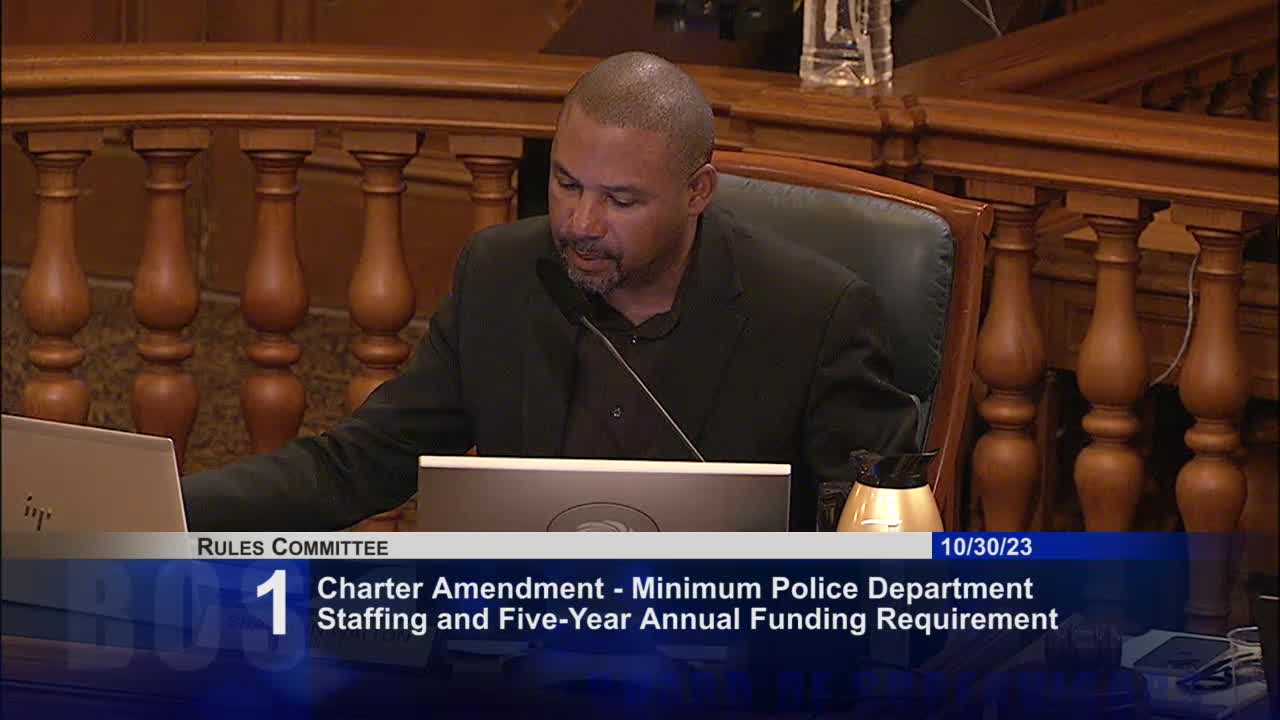San Francisco Supervisors Debate Police Staffing Amid Budget Deficit and Community Needs
October 30, 2023 | San Francisco County, California
This article was created by AI summarizing key points discussed. AI makes mistakes, so for full details and context, please refer to the video of the full meeting. Please report any errors so we can fix them. Report an error »

In a recent San Francisco County government meeting, discussions centered around a proposed charter amendment aimed at addressing police staffing and funding. The meeting highlighted a significant divide among supervisors regarding the best approach to public safety in light of a projected budget deficit exceeding $780 million.
Supervisor Walton expressed concerns about the amendment, arguing that it could lead to "blank checks" for police funding without addressing the underlying issues of community safety. He emphasized the need for a comprehensive approach that includes investments in mental health, affordable housing, and anti-poverty strategies, rather than solely increasing police resources. Walton pointed out that the police department is currently fully funded but struggles with staffing shortages, suggesting that the focus should be on improving the narrative around policing and building community trust.
Conversely, Supervisor Safaie advocated for increased police staffing, citing the importance of community policing and the need for officers to be visible in neighborhoods. He acknowledged the budget constraints but argued that the mayor could prioritize police recruitment in future budgets. Safaie proposed amendments to ensure that police foot and bike patrols are implemented effectively, aiming to enhance community relations and reduce crime.
The meeting also revealed tensions regarding the timing and transparency of the proposed charter amendment. Some supervisors criticized the rushed process, noting that they had only seen the amendment's details shortly before the meeting. They called for a more collaborative approach to ensure that any changes reflect the community's needs and priorities.
As the meeting concluded, the charter amendment was continued for further discussion, with supervisors agreeing to revisit the topic in the coming weeks. The ongoing debate underscores the complexities of balancing public safety, community trust, and fiscal responsibility in San Francisco, as officials grapple with how best to allocate limited resources amidst a significant budget deficit.
Supervisor Walton expressed concerns about the amendment, arguing that it could lead to "blank checks" for police funding without addressing the underlying issues of community safety. He emphasized the need for a comprehensive approach that includes investments in mental health, affordable housing, and anti-poverty strategies, rather than solely increasing police resources. Walton pointed out that the police department is currently fully funded but struggles with staffing shortages, suggesting that the focus should be on improving the narrative around policing and building community trust.
Conversely, Supervisor Safaie advocated for increased police staffing, citing the importance of community policing and the need for officers to be visible in neighborhoods. He acknowledged the budget constraints but argued that the mayor could prioritize police recruitment in future budgets. Safaie proposed amendments to ensure that police foot and bike patrols are implemented effectively, aiming to enhance community relations and reduce crime.
The meeting also revealed tensions regarding the timing and transparency of the proposed charter amendment. Some supervisors criticized the rushed process, noting that they had only seen the amendment's details shortly before the meeting. They called for a more collaborative approach to ensure that any changes reflect the community's needs and priorities.
As the meeting concluded, the charter amendment was continued for further discussion, with supervisors agreeing to revisit the topic in the coming weeks. The ongoing debate underscores the complexities of balancing public safety, community trust, and fiscal responsibility in San Francisco, as officials grapple with how best to allocate limited resources amidst a significant budget deficit.
View the Full Meeting & All Its Details
This article offers just a summary. Unlock complete video, transcripts, and insights as a Founder Member.
✓
Watch full, unedited meeting videos
✓
Search every word spoken in unlimited transcripts
✓
AI summaries & real-time alerts (all government levels)
✓
Permanent access to expanding government content
30-day money-back guarantee

